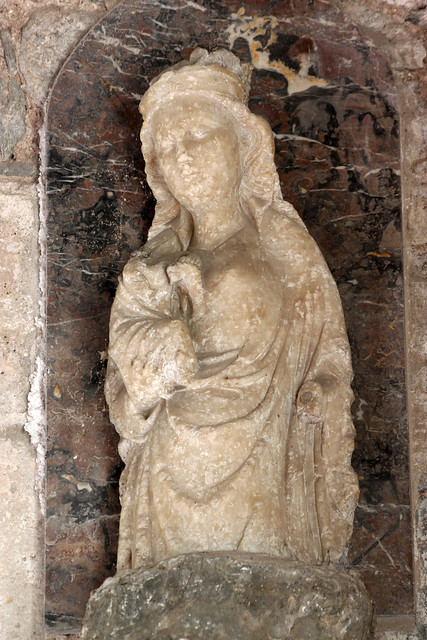A Medieval Image at Kidwelly in Carmarthenshire
 |
| The Kidwelly Virgin and Child |
Recently I visited Kidwelly in Carmarthenshire, where in the Middle Ages the ancient parish church of St Mary, was shared by a small Benedictine priory, a cell of Sherborne. High up on a bracket to the south of the high altar, in what was once the monastic quire, is a medieval image of the Virgin and Child, backed by a piece of marble. Carved from alabaster, the Virgin Mary gazes down at us as she holds the Infant Christ on her arm, he playing with a bird. The image is somewhat weathered and mutilated, the head of the Christ Child and her right arm being lost, but despite that the quality of the work is clear. A photograph in Daven Jones' History of Kidwelly published in 1908, shows the image displayed in the body of the church at which point it was clearly more complete than now, with fragments of a lost lower portion displayed along with what now remains. It is difficult to get a sense of the scale of the image in its current position as it is fifteen foot above the floor, but the 1908 photograph gives a sense that the image was monumental, a little over five foot tall and that the Virgin was originally standing.
When the photograph was taken in 1908 the figure had only recently begun to be appreciated again. Somehow, we don't know why, it survived the iconoclasm of the Reformation, first coming to notice in the 1840s when Daven Jones tells us it was to be found occupying a niche above the south door of the church, where it had been since time immemorial. He tells us that the ladies of the parish were accustomed to curtsey to the image on entering the church. It is hard not to interpret this behaviour as folk memory of the devotion paid to the image in the Middle Ages, though in truth we do not know that this was a cultic image or where the image was originally placed. In 1846 the vicar of the parish, troubled by his parishioners devotion, removed the image from the porch and had it buried it in the churchyard, It remained there until 1875 when it was retrieved and was then placed in the vestry. The present condition of the image is no doubt a consequence of the delicate alabaster enduring thirty years in the damp Welsh soil of the churchyard.
 |
| The Kidwelly image |
In 1922 the image was placed in its current location, twenty foot above the floor, where it is out of harms reach, but can't be appreciated as a work of art, unless you have binoculars or a zoom lens on your camera. I have the latter, so these images will allow you to appreciate it. As I'm sure the photographs demonstrate, the image though battered, is of outstanding. The swaying s-shaped posture of the image, and the deeply cut drapery, suggests a date in the later part of the fourteenth century.
 |
| The Flawford Madonna and Child |
The closest comparable work to it, both iconographically and stylistically, is the Madonna (illustrated above) that is now in the Nottingham Castle Museum but was found under the church floor at Flawford in Nottinghamshire in 1779. The s-shaped posture, drapery and the position of the Christ Child are very close in form to the Kidwelly Virgin and Child. The Flawford image, being more complete, gives a sense of the original appearance of the Kidwelly image. Like the Flawford Madonna, the Kidwelly Virgin and Child is almost certainly a product of the south Nottinghamshire alabaster workshops. A presence of a product of the Nottingham workshops in in the south of Wales, only serves to demonstrate the lengths medieval people went to to equip their churches and the connectedness of the British Isles in the late Middle Ages.
Bibliography
Daven Jones, D, A History of Kidwelly (Carmarthen, 1908), p. 72 and plate XV
Ambrose Jones, D. 'Figure of the Blessed Virgin at Kidwelly' in Archaeologia Cambrensis, 7th series 2 (1922), p. 415.





Comments